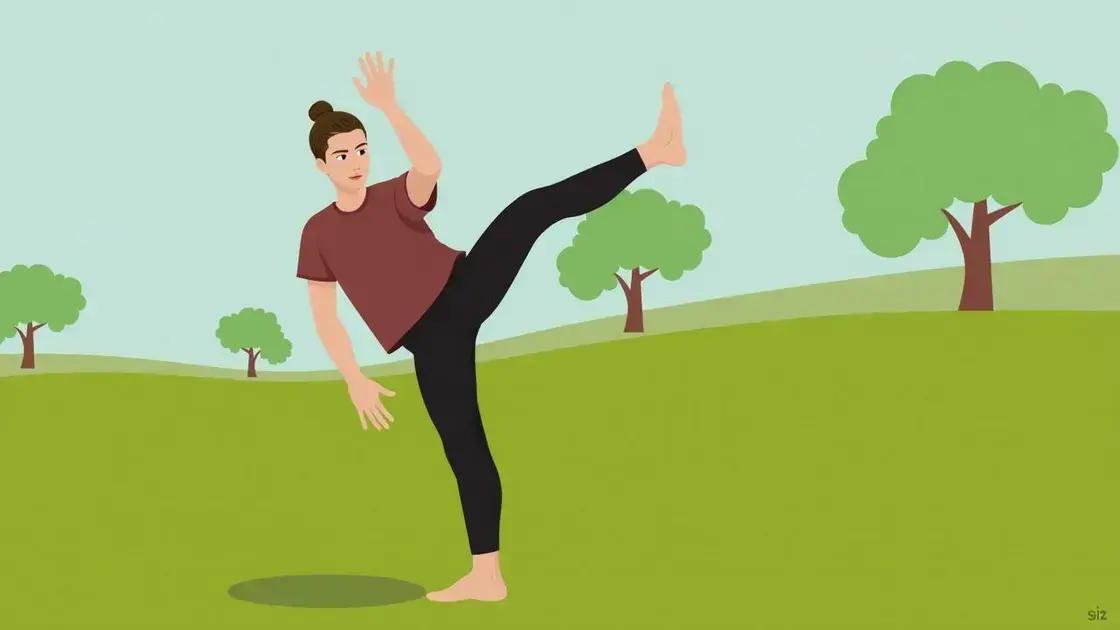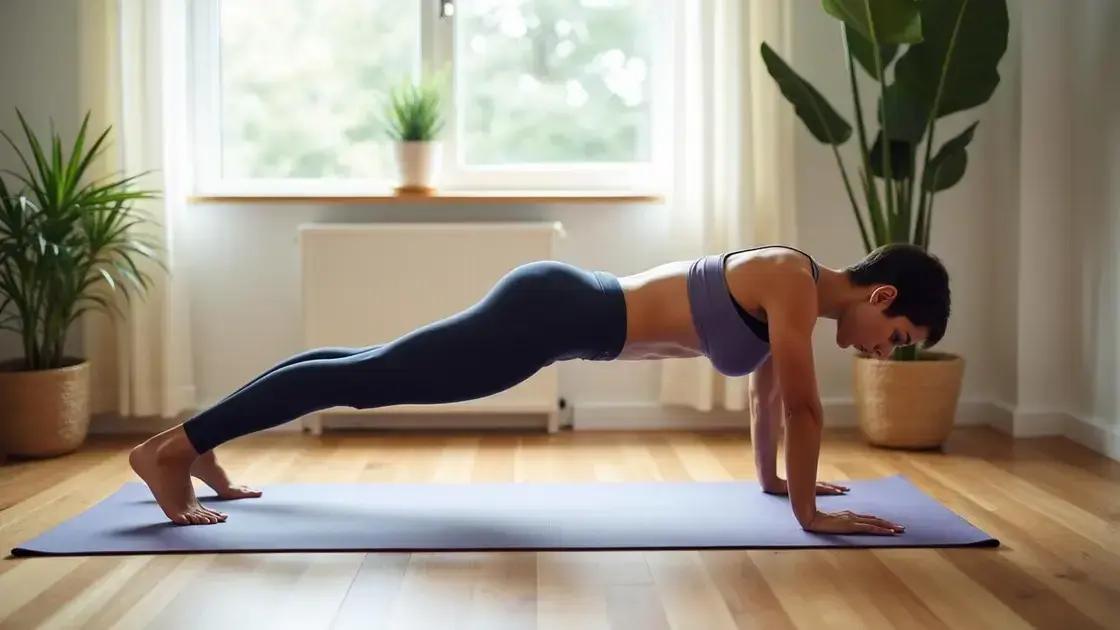Learning how to train for balance and core strength simultaneously involves incorporating exercises like planks, single-leg stands, and stability workouts into your routine. This combination improves stability, enhances athletic performance, and can prevent injuries, making it essential for anyone looking to elevate their fitness game.
Learning how to train for balance and core strength simultaneously is essential for anyone looking to improve their athletic performance or daily activities. Balance and core strength are interconnected, meaning that a stronger core can lead to better balance, while practicing balance exercises also enhances core stability. In this article, we will discuss effective exercises, the importance of training these areas together, and how to create a balanced workout routine that includes both aspects.
Understanding Balance and Core Strength

Understanding balance and core strength is crucial for improving physical performance and everyday functionality. Balance refers to the ability to maintain your center of gravity over your base of support. It’s vital for activities like walking, running, or even standing still. Core strength, on the other hand, focuses on the muscles in your abdomen, back, and pelvis. Together, they contribute to better posture, coordination, and stability.
Why Balance Matters
Balance helps prevent falls and injuries, especially as you age. Good balance allows you to perform activities safely and effectively, making it a fundamental part of any fitness routine.
The Role of Core Strength
Core strength supports your spine, allowing for proper posture and alignment while lifting or engaging in physical activity. A strong core can help alleviate back pain and improve overall athletic performance.
How They Work Together
Balance and core strength work in tandem. For example, standing on one leg (balance) requires your core muscles to engage in order to keep stable. Exercises that focus on both can lead to improved performance and reduce the risk of injury.
Incorporating balance and core training in your fitness routine is not just for athletes—it can benefit anyone who wants to enhance their physical abilities. By understanding these concepts, you can create a more effective training program.
Exercises to Enhance Balance

To enhance your balance, you can incorporate a variety of exercises into your routine. These exercises are designed to challenge your stability and can be easily modified to match your skill level. Here are some effective exercises to consider:
1. Single-Leg Stands
Stand on one leg for 30 seconds. For added difficulty, close your eyes or stand on a cushion. This exercise engages your core and improves your balance.
2. Heel-to-Toe Walk
Walk in a straight line by placing the heel of one foot directly in front of the toes of the other. Focus on keeping your balance and arms at your sides. This exercise helps develop coordination.
3. Balance Beam Walk
If you have access to a balance beam, walk across it slowly. If not, you can use a straight line on the floor. This exercise challenges your balance and focuses your mind.
4. Tai Chi
Tai Chi is a gentle exercise that combines slow, deliberate movements with deep breathing. It is known to improve balance and coordination while promoting relaxation.
5. Standing on One Leg with Movement
Stand on one leg and gently swing the other leg forward and backward. This dynamic movement increases your core engagement and helps improve overall stability.
Incorporating these exercises into your fitness routine can significantly enhance your balance. Aim to perform them consistently to see the best results.
Core Workouts for Stability

Core workouts are essential for building stability and strength in your midsection. A strong core helps you maintain balance and supports your spine. Here are some effective core workouts to improve your stability:
1. Plank
Get into a push-up position but rest on your forearms instead of your hands. Keep your body straight from head to heels. Hold this position for 20-60 seconds, focusing on engaging your core muscles.
2. Dead Bug
Lie on your back with your arms extended toward the ceiling. Bring your knees up to a 90-degree angle. Slowly lower your right arm and left leg toward the floor, then return to the starting position. Alternate sides for 10-15 reps.
3. Russian Twist
Sit on the floor with your knees bent and feet flat. Lean back slightly and lift your feet off the ground. With your hands together, twist your torso to the left, then to the right. Repeat for 10-15 reps to each side.
4. Bird Dog
Start on all fours with your knees under your hips and hands under your shoulders. Extend your right arm forward and left leg back while keeping your core engaged. Hold briefly, then switch sides. Perform 10-15 reps on each side.
5. Side Plank
Lie on your side and prop your body up on your forearm. Keep your body in a straight line and lift your hips off the ground. Hold this position for 15-30 seconds on each side to strengthen your obliques.
These core workouts can easily be added to your fitness routine. Aim for 2-3 sessions per week to see improvements in your stability and strength.
Integrating Balance and Core Training

Integrating balance and core training into your fitness routine is essential for overall stability and strength. By combining these two elements, you can create efficient workouts that target multiple muscle groups and enhance your body’s performance. Here are some effective strategies:
1. Combine Exercises
Incorporate exercises that challenge both your balance and core strength. For instance, try doing squats while lifting a kettlebell overhead. This engages your core while requiring stability to maintain balance.
2. Use a Stability Ball
Perform workouts using a stability ball. Sit on the ball for core exercises like crunches or planks. The instability of the ball forces your core to engage while maintaining balance.
3. Circuit Training
Create a circuit that alternates between balance and core exercises. For example, follow a set of balance drills like single-leg stands with a set of core exercises like Russian twists. This keeps your workout dynamic and effective.
4. Focus on Form
Prioritize proper form during workouts. Always engage your core muscles when doing balance activities. This will not only improve your stability but also prevent injuries.
5. Progress Gradually
Start with basic balance and core exercises before moving to more advanced variations. As you gain strength and stability, gradually increase the difficulty of your workouts. This helps to build a strong foundation over time.
By integrating these strategies into your training, you can achieve better results in both balance and core strength. Consistency is key, so aim to include these elements in your routine a few times a week.
Bringing It All Together: Balance and Core Strength Training
Training for balance and core strength simultaneously is essential for improving your physical performance and daily functional activities. By understanding the relationship between balance and core strength, you can effectively implement specific exercises that enhance both areas.
Engaging in targeted workouts, such as core stability exercises and balance-enhancing movements, will not only strengthen your midsection but also improve your overall stability. Integrating these elements into your fitness routine ensures a well-rounded approach to health and wellness.
Dedicated practice and consistency in training will lead to noticeable improvements in strength, balance, and confidence. By focusing on this dual training strategy, you’re setting yourself up for success in all aspects of life.
FAQ – Frequently Asked Questions about Training for Balance and Core Strength
Why is balance training important?
Balance training enhances stability, prevents falls, and improves overall physical performance, making it essential for daily activities and sports.
What are some effective exercises to improve balance?
Effective balance exercises include single-leg stands, heel-to-toe walks, and stability ball workouts, all designed to challenge your stability.
How does core strength contribute to stability?
Core strength supports your spine and helps maintain good posture, which contributes directly to overall stability while performing various activities.
Can I integrate balance and core workouts in one session?
Yes, integrating both into your workout can be beneficial. You can alternate exercises, such as doing a plank followed by balance drills.
How often should I train for balance and core strength?
Aim to train for balance and core strength 2-3 times a week for optimal results, allowing adequate rest to recover muscles.
Is it necessary to progress gradually in these workouts?
Yes, starting with basic exercises and gradually increasing intensity helps build a strong foundation and prevents injuries.













